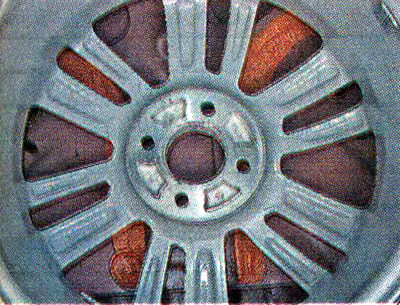
The manufacturer installs wheels with steel or alloy wheels for tubeless tires on the car (see above, «Reference data»). The alloy wheel markings are cast on the inside of the spokes.
The marking of the steel disc can be stamped on the rim.
The designation of the wheel disk is deciphered as follows:
- 6 - rim width in inches;
- J - symbol of the rim profile;
- 15 - rim diameter for the tire in inches;
- 4x100 - the number of holes for wheel bolts and the diameter on which they are located;
- DIA60.1 - bore diameter;
- ET - symbol for rim offset;
- 50 - rim offset in millimeters;
- 2013 10 7 is the date of manufacture.
Comment. Rim offset (ET) is the distance between the plane dividing the wheel rim in half (plane equidistant from the rim flanges) and mating (fixing) wheel plane.
Wheels are equipped with tubeless tires. The European tire designation, for example 185/65R15 92H, stands for:
- 185 - profile width in millimeters;
- 65 - the ratio of the profile height to its width in percent;
- R is the designation of the radial tire;
- 15 - tire diameter in inches;
- 92 - load index (tab. 11.1.3);
- H - speed index (tab. 11.1.4).
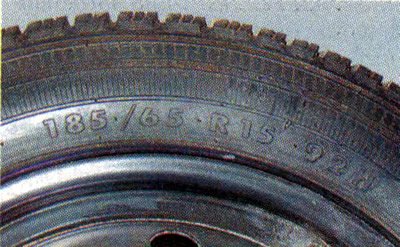
Comment. Load index - an index indicating the maximum allowable load on the tire, the excess of which can lead to tire failure. Speed index - an index indicating the maximum allowable speed for a given tire. Exceeding this speed may result in tire failure.
The American tire designation, for example P 185 / 65R15 84T, is deciphered in the same way. An additional letter before the designation indicates the purpose of the tire: P (Passenger) – car tyre, LT (Light Truck) - Tire for light truck.
The tire may also carry a DOT certification number if the tire has been tested to U.S. Department of Transportation standards.
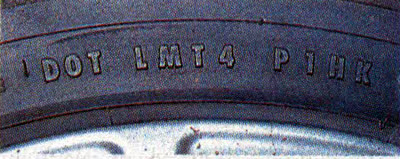
In this case, markings are applied on the sidewall of the tire, informing about the relative qualities! rubber:
TREADWEAR - characterizes the wear resistance of the tire: the higher the index value, the higher the wear resistance of the tire (like a tire! with an index of 300 has a resource three times longer than a tire with an index of 100).
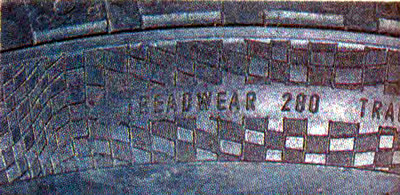
TRACTION - characterizes the tire's ability to brake on wet pavement without slipping. Measurements are carried out according to a special technique with a rectilinear movement of the car.
Warning! This measurement method does not take into account the behavior of the tire when braking in a corner and on other road surfaces.
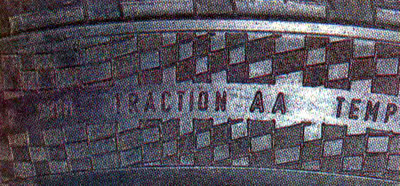
The letters printed next to the word TRACTION indicate the relative value of this tire parameter. The following options are possible (in descending order): AA, A, B, C.
TEMPERATURE - characterizes the tire's resistance to heat generation and its ability to dissipate heat energy. Measurements are carried out according to a special technique.
Warning! Exceeding the load and speed limit, as well as insufficient pressure can lead to overheating and destruction of the tire.
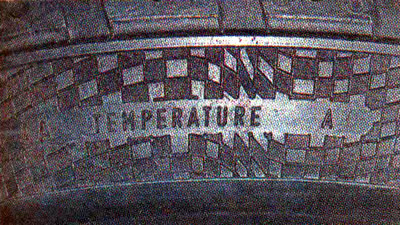
Index C indicates that the tire meets the minimum requirements of the safety standard. Indices B and A show the excess of these minimum requirements in ascending order. The following designations can also be applied to the sidewall of the tire: RADIAL - designation of a radial tire; TUBELESS - this inscription means that the tire is tubeless.
Giving recommendations in the choice of certain tires, the manufacturer proceeds from the conditions for ensuring maximum stability, handling, patency and safety of the car. So, wheels with a long reach can touch the parts of the brake mechanisms and suspension, and with a smaller one, they increase the load on the hub bearings and can lead to unpredictable behavior of the car during emergency braking or in the event of a failure of one of the brake system circuits. High-profile tires can rub against body parts at maximum suspension travel, and wide tires can rub against the car's side member or fender at large turning angles. A tire with a lower load index may burst under the maximum load of the vehicle, and using a tire with a low speed index is fraught with destruction when driving at high speed.
Tires that can be installed on a car, depending on the temperature and weather conditions for which they are designed, are divided into three types: summer, winter and all-weather. If the car is used all year round and the winter is snowy, it is better to have two sets of wheels: with winter and summer tires. Summer tires are specially designed to operate in high temperatures. In winter, summer tires will be too hard, which will negatively affect their grip on the road. Winter tires provide acceptable traction at low temperatures and on icy or snowy road surfaces. These tires are made from softer rubber. They are marked with sign 1 in the form of a mountain peak with three peaks and a snowflake inside it, as well as signs 2 «M+S», «M&S», or «M S» (letters from English, mud - «dirt» and snow- «snow», indicate that the tire has increased spacing between the tread lugs to resist skidding on uneven ground).
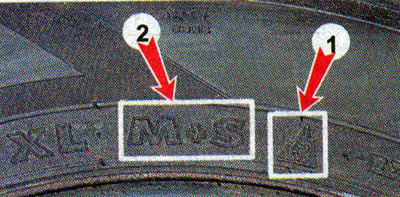
The inscription STUD indicates the presence of spikes. The possibility of using studded tires in winter depends on the specific operating conditions of the car. Keep in mind that studs are designed to improve the traction of a tire only on slippery hard surfaces such as ice or packed snow. In other cases, the spikes are useless, and on asphalt they can even slightly worsen the grip of the tire with the road.
The use of a winter tire in the summer leads to intensive wear.
All season tires can be used all year round. They are distinguished from other tires by the inscription: ALL SEASON or TOUS TERRAIN on the sidewall. In terms of their performance, they behave satisfactorily in various weather conditions, but at the same time they lose in terms of technical indicators to summer tires in summer, and to winter tires in winter. All-season tires are best for the off-season.
Depending on the height of the profile, tires are divided into low-profile (the ratio of the profile height to its width is equal to or less than 55) and high profile (the ratio of the profile height to its width is greater than 55). The smaller the profile of the tire, the stiffer its sidewall and, accordingly, the tire absorbs road bumps less, however, with a decrease in the profile, steering accuracy increases.
The tread pattern can be universal or directional and is not regulated by the requirements of the vehicle manufacturer. With a directional tread pattern, the sidewall of the tire has the inscription ROTATION and an arrow indicating the direction of rotation of the wheel when the vehicle is moving forward.
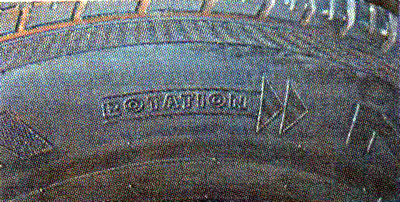
A special case of a directional pattern is asymmetric. In this case, the inscription OUTSIDE is applied on the sidewall, which must be on the outside during installation.
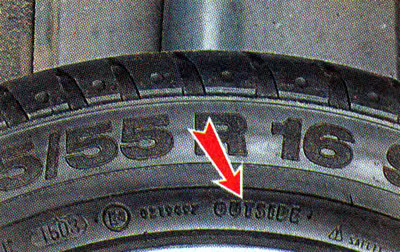
On the tread of some types of tires, narrow wavy slots - sipes - can be made.
Table 11.1.3. Tire load indices
| Index | Load, kg | Index | Load, kg | Index | Load, kg | Index | Load, kg |
| 51 | 195 | 71 | 345 | 91 | 615 | 111 | 1090 |
| 52 | 200 | 72 | 355 | 92 | 630 | 112 | 1120 |
| 53 | 206 | 73 | 365 | 93 | 650 | 113 | 1150 |
| 54 | 212 | 74 | 375 | 94 | 670 | 114 | 1180 |
| 55 | 218 | 75 | 387 | 95 | 690 | 115 | 1215 |
| 56 | 224 | 76 | 400 | 96 | 710 | 116 | 1250 |
| 57 | 230 | 77 | 412 | 97 | 730 | 117 | 1285 |
| 58 | 236 | 78 | 425 | 98 | 750 | 118 | 1320 |
| 59 | 243 | 79 | 437 | 99 | 775 | 119 | 1360 |
| 60 | 250 | 80 | 450 | 100 | 800 | 120 | 1400 |
| 61 | 257 | 81 | 462 | 101 | 825 | 121 | 1450 |
| 62 | 265 | 82 | 475 | 102 | 850 | 122 | 1500 |
| 63 | 272 | 83 | 487 | 103 | 875 | 123 | 1550 |
| 64 | 280 | 84 | 500 | 104 | 900 | 124 | 1600 |
| 65 | 290 | 85 | 515 | 105 | 925 | 125 | 1650 |
| 66 | 300 | 86 | 530 | 106 | 950 | 126 | 1700 |
| 67 | 307 | 87 | 545 | 107 | 975 | 127 | 1750 |
| 68 | 315 | 88 | 560 | 108 | 1000 | 128 | 1800 |
| 69 | 325 | 89 | 580 | 109 | 1030 | 129 | 1850 |
| 70 | 335 | 90 | 600 | BY | 1060 | 130 | 1900 |
Table 11.1.4. Tire speed indices
| Index | Speed, km/h | Index | Speed, km/h |
| TO | 110 | T | 190 |
| L | 120 | And | 200 |
| M | 130 | H | 210 |
| N | 140 | V | 240 |
| R | 150 | VR | over 210 |
| Q | 160 | W | 270 |
| R | 170 | Y | 300 |
| S | 180 | ZR | over 240 |
